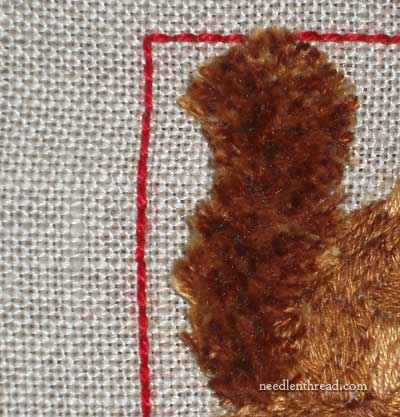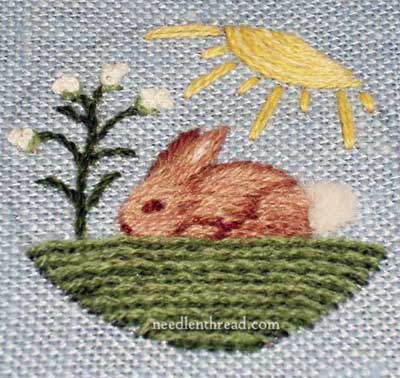Turkey work (or Ghiordes Knot) is an embroidery technique that creates a thick carpet-like pile on the fabric. It’s great fun, and it’s a wonderful way to create, for example, animal tails.

Sometimes, though, before the Turkey work is brought under control with a good haircut, it can look a bit like your whole thread stash, gone haywire. The photo above is a good example. This was worked by Anna, and this is how the conversation went:
Me: Wow, Anna, it looks like those loops are a bit long.
Anna: It makes it easier to hold the loops out of the way.
45 minutes later:
Anna: I’m running out of thread.
Me: No, really?
I have to admit, once the thread was trimmed, the tail looked pretty good.

I’ll show you the rest of this a bit down the road – he needs a bit of tweaking.

This little bunny, embroidered in Fine D’Aubusson wool and situated in a 1.75″ circle, has a much more modest Turkey work tail. Doesn’t she look content?
If you’re ever stitching up a wee animal, consider Turkey work for the tail. It’s a lot of fun!







So stinking cute!
I love Turkey work! I tend to like its “organic” state (before trimming).
By the way, those tiny embroideries are too cute!
PS: {I’ve been MIA but keeping up with the email updates and on the watch for the collection of Little Things …. which for some reason I have the feeling today’s
small embroideries may be part of, or so I hope ;-).}
Turkey work huh? I have heard of it but never tried it. I think I would find it frustrating as all get out. I learned to embroider in the 4th grade, but didn’t even do french knots and some other stitches until I was about 25 because they always got tangled and I had no one to ask for advice or anything (internet did not exist when I was a child). After I bought a stitch encyclopedia when I was about 25 I realized that I had to monitor the french knot thread as I pulled it through, no one told me that when I was a kid so the knots and other stitches would always frustrate me. The rabbit and squirrel are cute though. 🙂
Hi Mary! Thanks for “talking turkey”!! I’m so glad you showed Anna’s squirrel (that appears to be cotton), as well as your wooly bunny. When I’ve stitched turkey work, I’ve always used cotton floss. But last week I was admiring a friend’s crazy quilt that had the most delightful fluffy flowers & they were clearly “not cotton”. When I asked her, she said she used rayon thread! SO–I wondered if you would say a few words about working with various fiber content threads for this technique? BTW–I use a Bunka brush to fluff my floss & consider it a good investment.
It does make nice tails, and tales. It is also great for hair on people, but the best thing I ever did with this stitch was a thistle.
By the way, what is a bunka brush please?
It’s a tiny brush with metal tines that is used for a type of Japanese dimensional embroidery that employs rayon thread. The tines are mounted on a small leather strip in the shape of an “O” that fits over two fingers, making it easy to use & control. It’s a useful tool for anything you want to fray out because the tines are quite small & gentle.